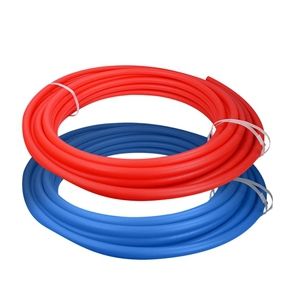Considering repiping your home? One of the most difficult decisions you’ll make is choosing the type of pipe you want to use. We’ve put together a handy guide with everything you need to know to make the best choice for your needs.
Let’s talk about what’s best, and what you should consider avoiding.
Copper: The Gold Standard
Copper is the top choice of many plumbers because it has a proven history of excellence. Copper pipes installed 80 years ago are still going strong — it’s an incredibly reliable and durable material. It’s also heat tolerant and corrosion resistant.
Despite its stellar performance stats, copper does have a number of issues. First, there’s the price tag — 100 feet of copper pipe can cost around $285 (dependent on the market price, which fluctuates constantly). There are also some environmental concerns. While copper pipes will not pollute your drinking water and old pipes can be recycled, copper mining and manufacturing are extremely harmful to the environment. If you’re looking for a green choice, this is something to consider.
PEX: The Next Big Thing
Cross-linked polyethylene (PEX for short) is an extremely popular choice today. It’s much cheaper than copper (around $30 for 100 feet) and is extremely flexible. One piece could potentially wind through your entire house — corners and obstacles are no problem. And unlike copper, it doesn’t need to be soldered at the joints. It’s quick to install, which cuts down on labor costs, and, like copper, it’s corrosion resistant. One last advantage? It can expand up to eight times its size before it freezes.
So, what’s the downside? PEX has only been in widespread use for about 10 years, so we don’t have a lot of data on its longevity. Some plumbers prefer to use a more proven material. Also, PEX is easily damaged by UV rays, so it cannot be used outdoors. Finally, the process used to make PEX has been linked to an environmental toxin; there’s some fear that it could contaminate drinking water. On the other hand, California (known for having extremely strict environmental regulations) has approved PEX for use there.
Are There Other Choices?
There are, but in most cases, either the pros far outweigh the cons, or the pipe is only usable in specific places or applications. Take PVC for example. It’s inexpensive, easy to install, and won’t rust or corrode. However, hot water causes it to warp, so its usage is limited. Its cousin, CPVC (the initial C stands for “chlorinated”, which makes it safe for drinking water), can be used for hot and cold water but the pipe is easily damaged when it freezes. There’s also stainless steel, which can be either flexible or rigid and is extremely resistant to corrosion but is even more expensive than copper.
If you’re planning on repiping your entire house, copper or PEX are going to be your best choices.
PVC or CPVC might do the job if you’re just looking to replace small sections. Your home’s age, foundation, and overall health might also determine what type of pipe will best suit your needs. Knowing the pros and cons of the most common options can help you make a more informed decision; your plumber can fill in the missing pieces to make sure your new pipes are a perfect fit!

